à traduire...
Contents of this page:
1. Introduction
2. Alternative energy supplies and
technologies
- Direct solar
- Thermal energy storage
- Use of biomass
- Direct geothermal
- Direct earth or water source and heat pump
systems
- Solar, small hydro and wind power
- Cogeneration
3. Study in depth
1. Introduction
Most urban areas almost entirely
rely on conventional energy supplies, such as grid electricity,
gas and fuel. However, several potential on-site renewable resources
and high-efficiency supply technologies do exist. The objective
is to determine how much of the energy demands can be met in a more
renewable or sustainable manner than by serving all of the neighborhood’s
needs with conventional supplies and how these technologies can
be integrated into neighbourhood.
First of all, potentialities of available resources
and local territorial predispositions should be evaluated:
- Solar radiation
- Wind energy
- River, lakes, ground water
- Geothermal heat
- Biomass
- Industrial and agricultural byproducts, waste
- Existing infrastructures
- ...
District heating and cooling
DHC is the production of hot
and cold water at a central neighborhood plant for distribution
to nearby buildings for their heating and cooling. A local distribution
network must be carefully planned.
Whilst conventional energies
(electricity, gas, fuel) can be easily transported over big distances
(> 100km), heat can only be distributed over short distances
(100m, in the best case some kilometers for big-scale geothermal
plants). Considering this, heat/cold should be produced where it
is used. Prefer transport of the energy agent rather than heat or
cold itself.
2. Alternative energy supplies and
technologies
The systems listed below are
known as “distributed” (rather than “centralized“)
technologies. These plants and technologies are smaller and cleaner
than conventional generation systems. For these reasons, they can
be located close to the energy users and provide more efficient
power. They include:
Solar direct-use
This includes passive use through building orientation
(windows) and active heating via thermal solar collectors. Good
solar access must be granted to potential surfaces.
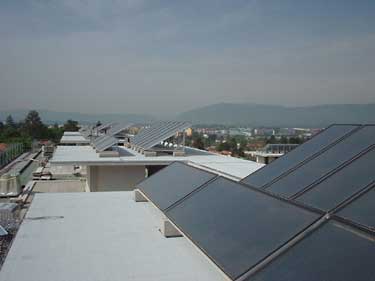
Apartment building "Les Pommiers",
Geneva: solar collectors for domestic hot water production
Source: www.easysolar.ch
(2005)
Excessive heat may be stored
for later usage.
Thermal energy storage
In regions that are especially
warm or cold, storing thermal energy in the form of hot or cold
can reduce the capacity needed by community supply systems during
hot or cold periods. These systems are generally referred to as
seasonal thermal storage in the case of storing
heat during summer for heating during winter, or diurnal when storing
cool from the night for use during daytime. An example is buried
pipe pre-cooling that can be simple and effective if properly designed.
Use of biomass
In regions that are close to
woodlands or farming, use of biomass can be of interest for heating
(wood firing) or production of biogas. In the case of woodfiring,
air pollution due to NOx production must be taken into account.
Available technology make wood heating more efficient for close
neigbourhood heat supply or DHC. Heat from domestic waste incineration
may be used for DHC.
Geothermal direct-use
Some places have low temperature
geothermal resources that are warm enough to be used directly for
building and process heating. These are resources in the 35°C
to 50°C range. High temperature geothermal mining is based on
cost intensive deep mining thechnology which makes this thechnology
only suitable for medium to big size installations (district heating).
Big plants can also pruduce electricity.
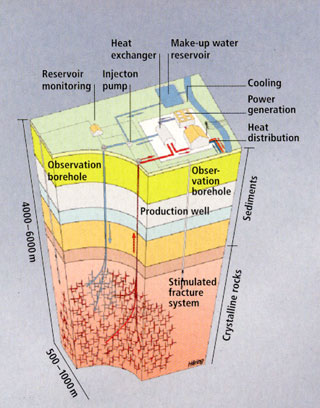
Direct earth or water source and heat pump
systems
Direct use of ground water and/or surface water
may be an efficient means of preheating or cooling of buildings.
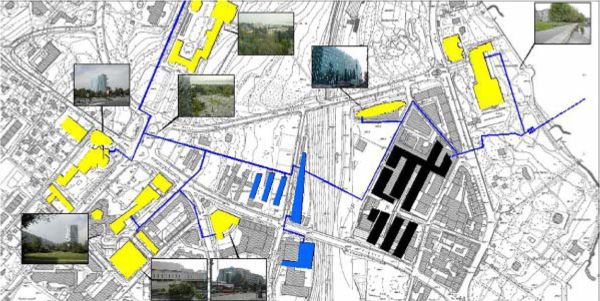
Geneve - Lac - Nations, lake water
used for district precooling/preheating in Secheron
Source: séminaire CUEPE, GENEVE_Infrastructures_et_energie_Seminaire_CUEPE_Remy_Beck_2004.pdf
Heat pumps coupled to the earth
or groundwater can be a highly efficient method of heating and cooling
buildings. But, basically, heat pumps should be considered as improved
electrical heating systems. They do not produce energy but consume
less energy.
Solar, small hydro and wind
power
In some neighborhoods, solar,
small hydro and wind power generation may be feasible, depending
upon local resource characteristics and electric rates. Use of solar,
hydro or wind for power generation allows a reduction in the amount
of electricity that must be “imported” into the neighborhood
via the community electric grid. Such reductions not only make the
neighborhood more self-reliant and sustainable, but also extend
the capacity and life of the community electric grid.
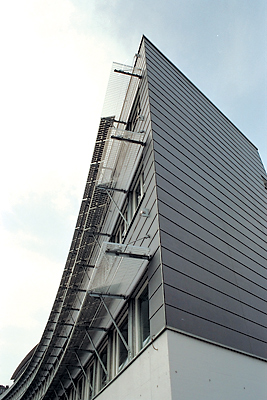
Office and Apartment Building "Stahlrain"
in Brugg: sun screens in the shape of hinged grills and photovoltaic
panels
Source: www.idea-architecture.org
(2005)
Photovoltaic solar power generation
requires optimum solar access in order to optimise payback from
an economic and energy point of view.
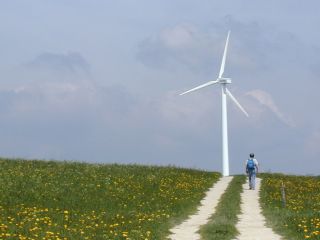
Wind plant at Mont Soleil in Switzerland
Source: CUEPE 2001
Specially windpower requires
excellent integration due to nuisances from noise, vibrations and
turbulence.
Cogeneration
Cogeneration is the process
of generating electricity and DHC together to increase the efficiency
of both processes. Cogeneration plants are often conventionally
fueled, but can sometimes use neighborhood renewable resources as
partial fuel sources. Use of a cogeneration plant means that its
electrical output can be subtracted from the amount needed from
the community grid and its DHC output can be subtracted from displaced
conventional heating and cooling fuels.
SOURCE: freely adapted and
completed from PLACES3 http://www.energy.ca.gov/places/
(document: http://www.energy.ca.gov/places/EXECSUMM.PDF),
08 august 2005
3. Study in depth
GENEVE_Infrastructures_et_energie_Seminaire_CUEPE_Remy_Beck_2004.pdf
Assessement_for_solar_energy_application_in_urban_sites_Eurosun2002_poster.pdf
Assessement_for_solar_energy_application_in_urban_sites_Eurosun2002_text.pdf
Le_gisement_solaire_en_zone_urbaine_seminaire_cuepe_2003.pdf
Solar_and_daylight_availability_in_the_urban_fabric.pdf
Solar_energy_utilisation_potential_of_3_swiss_urban_sites_2003.pdf
Photovoltaics_in_Architecture_Othmar_Humm.pdf
pg / 17-08-2005 / mailto
|
![]()